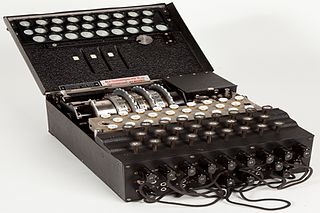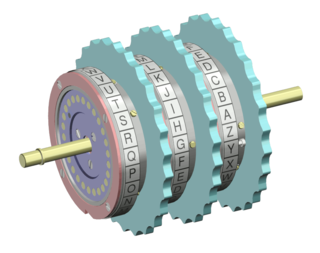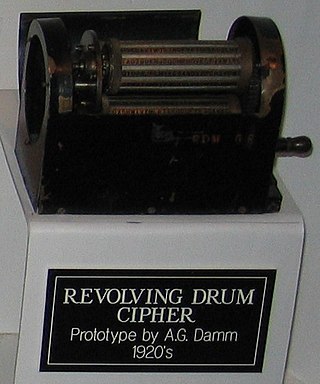
The Enigma machine is a cipher device developed and used in the early- to mid-20th century to protect commercial, diplomatic, and military communication. It was employed extensively by Nazi Germany during World War II, in all branches of the German military. The Enigma machine was considered so secure that it was used to encipher the most top-secret messages.

In cryptography, encryption is the process of encoding information. This process converts the original representation of the information, known as plaintext, into an alternative form known as ciphertext. Ideally, only authorized parties can decipher a ciphertext back to plaintext and access the original information. Encryption does not itself prevent interference but denies the intelligible content to a would-be interceptor.

In cryptography, a rotor machine is an electro-mechanical stream cipher device used for encrypting and decrypting messages. Rotor machines were the cryptographic state-of-the-art for much of the 20th century; they were in widespread use in the 1920s–1970s. The most famous example is the German Enigma machine, the output of which was deciphered by the Allies during World War II, producing intelligence code-named Ultra.

The Lorenz SZ40, SZ42a and SZ42b were German rotor stream cipher machines used by the German Army during World War II. They were developed by C. Lorenz AG in Berlin. The model name SZ was derived from Schlüssel-Zusatz, meaning cipher attachment. The instruments implemented a Vernam stream cipher.

The Siemens & Halske T52, also known as the Geheimschreiber, or Schlüsselfernschreibmaschine (SFM), was a World War II German cipher machine and teleprinter produced by the electrical engineering firm Siemens & Halske. The instrument and its traffic were codenamed Sturgeon by British cryptanalysts.

Boris Caesar Wilhelm Hagelin was a Swedish businessman and inventor of encryption machines.

The M-94 was a piece of cryptographic equipment used by the United States Army, consisting of several lettered discs arranged as a cylinder. It was also employed by the US Navy, under the name CSP 488.

In cryptography, the M-209, designated CSP-1500 by the United States Navy is a portable, mechanical cipher machine used by the US military primarily in World War II, though it remained in active use through the Korean War. The M-209 was designed by Swedish cryptographer Boris Hagelin in response to a request for such a portable cipher machine, and was an improvement of an earlier machine, the C-36.

Arvid Gerhard Damm was a Swedish engineer and inventor. He designed a number of cipher machines, and was one of the early inventors of the wired rotor principle for machine encipherment. The company, AB Cryptograph, was an early predecessor of Crypto AG.

The HC-9 was a mechanical cipher device manufactured by the Swedish company AB Transvertex. It was designed in the early 1950's for the Swedish Armed Forces and in use from 1963 to 1995 as Krypteringsapparat 301. This machine was used for low-level communications such as platoon, company, up to battalion levels and in regimental and brigade staffs.The machine dimensions are 18 x 15 x 7 cm.

The (Hagelin) CD-57 was a portable, mechanical cipher machine manufactured by Crypto AG, first produced in 1957. It was derived from the earlier CD-55, and was designed to be compatible with the larger C-52 machines. Compact, the CD-57 measured merely 5 1/8in × 3 1/8in × 1 1/2in and weighed 1.5 pounds. The CD-57 used six wheels.

The (Hagelin) C-52 and CX-52 were cipher machines manufactured by Crypto AG starting 1951/1952. These pin-and-lug type cipher machines were advanced successors of the C-38/M-209. The machine measures 8+1⁄2 by 5+3⁄8 by 4+3⁄8 inches. The device is mechanical, but when combined with an electric keyboard attachment, the B-52, the resultant system is termed the BC-52. The B-52 is larger, measuring 12+1⁄2 by 8+1⁄2 by 6+3⁄8 inches.

The C-35 and C-36 were cipher machines designed by Swedish cryptographer Boris Hagelin in the 1930s. These were the first of Hagelin's cipher machines to feature the pin-and-lug mechanism. A later machine in the same series, the C-38, was designated CSP-1500 by the United States Navy and M-209 by the United States military, who used it extensively.

In the history of cryptography, 91-shiki ōbun injiki or Angōki Taipu-A, codenamed Red by the United States, was a diplomatic cryptographic machine used by the Japanese Foreign Office before and during World War II. A relatively simple device, it was quickly broken by western cryptographers. The Red cipher was succeeded by the Type B "Purple" machine which used some of the same principles. Parallel usage of the two systems assisted in the breaking of the Purple system.
Ostwin Fritz Menzer was a German cryptologist, who before and during World War II, worked in the In 7/VI, the Wehrmacht signals intelligence agency, later working in that was the cipher bureau of the supreme command of the Nazi party, and later in Abwehr, the military intelligence service of the Wehrmacht. He was involved in the development and production of cryptographic devices and procedures, as well as the security control of their own methods.
Otto Buggisch was a German mathematician who, during World War II, was a cryptanalyst working in the cipher bureau, the Cipher Department of the High Command of the Wehrmacht (OKW/Chi) responsible for deciphering of the opposing forces Communications. He also dealt with the security control of own key procedures. Through research and revelations exposed by two Polish officers, late in the war, he recognized the true cryptographic weaknesses of the Enigma rotor cipher, key machine used by the German armed forces to encrypt their secret communications, in World War II.
The Schlüsselgerät 39 (SG-39) was an electrically operated rotor cipher machine, invented by the German Fritz Menzer during World War II. The device was the evolution of the Enigma rotors coupled with three Hagelin pin wheels to provide variable stepping of the rotors. All three wheels stepped once with each encipherment. Rotors stepped according to normal Enigma rules, except that an active pin at the reading station for a pin wheel prevented the coupled rotor from stepping. The cycle for a normal Enigma was 17,576 characters. When the Schlüsselgerät 39 was correctly configured, its cycle length was characters, which was more than 15,000 times longer than a standard Enigma. The Schlüsselgerät 39 was fully automatic, in that when a key was pressed, the plain and cipher letters were printed on separate paper tapes, divided into five-digit groups. The Schlüsselgerät 39 was abandoned by German forces in favour of the Schlüsselgerät 41.
Hans-Peter Luzius was a German actuarial mathematician and economist. Luzius was most notable for his work oduring World War II on researching a method to cryptanalyse the M-209 mechanical cipher machine that led to the first recovery of key based on a crib, while he was conscripted to the Inspectorate 7/VI, the signals intelligence agency of the Wehrmacht, while based at Matthäikirchplatz in Berlin, close to Bendlerblock.
Cryptograph was a limited Swedish company developing and selling crypto machines, founded on 21 July 1916 and liquidated in 1930. It was probably the first company in the world to focus entirely on the cryptographic market.














